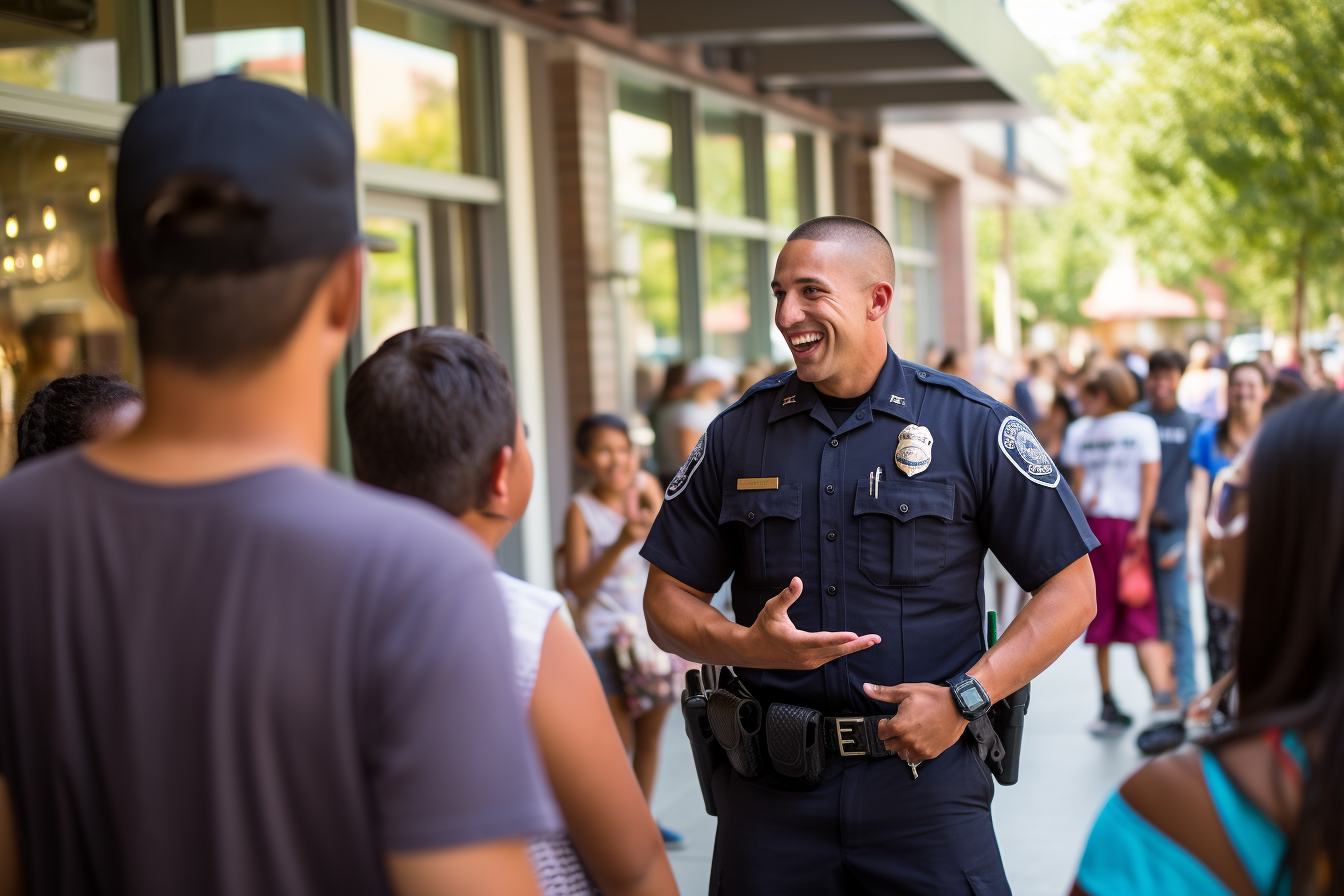Blog
Home > Blog

Guarding Our Neighborhoods
We're all on duty when it comes down to protecting our neighborhoods. When law enforcement teams up with local people based on mutual respect, plus using sharp tactics for stopping crimes early on – that’s when you really start seeing neighborhoods turn around for the better. Ready to learn more? Let's dive in.
Did you know that communities with strong social ties and trust in law enforcement tend to have lower crime rates? It's true! Working hand in hand and nurturing good vibes among us is our secret to crafting spaces where safety shines for all. So, what does it take to build a safer community? We have some key strategies to consider.
Community Policing Strategies for Improved Safety
The main goal of community policing is to knit a fabric of trust and respect that connects police officers closely with the people they're here to protect. It's not just about catching bad guys - it's about engaging key community members, emphasizing healing, and investing in anti-violence workforce development.

Building Trust and Legitimacy
At the heart of community-based policing is the idea that when police and residents work together, everyone benefits. For genuine trust to blossom within a neighborhood, police need to step out of their vehicles and dive into real talks with the people. Listening to their concerns, their fears, their hopes for the neighborhood. It's about seeing each other as human beings, not just uniforms and civilians. That kind of genuine connection is the foundation for community partnerships that can transform safety.
Engaging Key Community Members
Effective community policing means identifying and engaging the key players in a neighborhood- the respected elders, the activists, the youth leaders. The folks who have the pulse of the community. Police can't be everywhere all the time. Teaming up with key community influencers can really broaden their impact and spread. These are the people who can help mobilize residents, quell rumors, and provide valuable intel. It's not about snitching - it's about building a web of relationships that can prevent and solve crimes. In communities that have experienced high levels of violence and mistrust of police, the trauma runs deep. You can't just slap a band-aid on it and expect everything to be okay.
At its heart, community policing recognizes the trauma folks face and zeroes in on healing as a priority. It means training officers in de-escalation and mental health first aid. Connecting residents to counseling and support services. Hosting community forums and listening sessions where people can share their pain and start to find common ground. Healing isn't easy or quick, but it's essential for building community trust and improving safety in the long-run.
Investing in Anti-Violence Workforce Development
Bringing in locals as trained violence interrupters and outreach staff shines as a bright spot in the playbook for community policing. These are the "credible messengers" - who better to reach out to high-risk individuals and steer them in a more positive direction? Violence interrupters can often de-escalate conflicts before they turn deadly. They can connect people to job training, education, and mental health services. Investing in this anti-violence workforce is a win-win. It creates good jobs for community members while also making the neighborhood safer. And it builds trust between police and residents by showing a commitment to shared responsibility for public safety.
Effective Crime Prevention Techniques
Sure, having officers out and about in the neighborhood is great. But let's not forget, we've got to get ahead of crime with smart plans that stop trouble before it even starts. That means using data and intelligence to identify the key people and places driving violence in a community.
Identifying Key People and Places Driving Violence
In any given community, a small number of individuals are usually responsible for a large portion of the crime. These are the chronic offenders, the crime drivers. Likewise, certain locations - known as "hot spots" - tend to be hubs for criminal activity. Focused deterrence strategies hone in on these key people and places. The idea is to put the heat on the crime drivers with targeted enforcement and surveillance. At the same time, social services and community supports are offered as a carrot. The goal is to change the behavior of those individuals who are causing the most harm. And to reclaim those crime hot spots for the community.
Creating a Plan for Engaging High-Risk Individuals
Once you've identified the key people driving crime, you need a plan for engaging them. This is where partnerships with social service providers are crucial. Law enforcement can't go it alone - they need to work hand-in-hand with mental health professionals, substance abuse counselors, job trainers, and other experts. Working as a team lets them put together custom-fit solutions like no other.
The message to the high-risk individual is: we know what you're up to, and we want you to stop. Here's some help to get you on a better path. But if you keep breaking the law, there will be swift and certain consequences. It's a carrot and stick approach that has shown promising results in reducing gun violence and recidivism.
Addressing Key Locations with Place-Based Policing
Just as you can target high-risk individuals, you can also target high-risk locations. Place-based policing strategies aim to disrupt crime hot spots and restore public safety. Imagine making our community safer - that might include adding better lighting along streets and parking lots, setting up new surveillance cameras, covering up deserted structures, or even bringing in more police patrols. It can also mean organizing community clean-ups and block parties to encourage positive activity. Think of it as putting a wrench in the works where crime loves to hang out and grow. And to empower the community to take back those spaces.
Utilizing Data and Evidence for Continuous Improvement
To know if these crime prevention strategies are actually working, you need good data and rigorous evaluation. That means tracking crime trends, analyzing incident reports, and gathering community feedback. Departments should be constantly assessing what's working and what's not. They should be open to trying new approaches and learning from other jurisdictions. They should be transparent with the public about their goals, their strategies, and their progress. Evidence-based policing is all about using data and science to continuously improve and adapt. It's an acknowledgment that we don't have all the answers - but we can keep getting better at preventing and reducing crime.
Setting Clear Goals for Saving Lives
To make real progress on public safety, you need clear and measurable goals. It's not enough to just say "we want less crime." You need to put numbers to it. For example, a city might set a goal of reducing homicides by 20% over the next 3 years or cutting the number of non-fatal shootings in half. Having those specific targets keeps everyone focused and motivated. Watching progress unfold becomes straightforward, as does nudging people to stay committed. And it sends a message to the community that saving lives is the number one priority.
No one has all the answers when it comes to preventing violence. But by learning from each other, we can get a lot further than going it alone. That's where peer-to-peer learning comes in. It's about police departments, community groups, and service providers sharing their successes and challenges with each other. It can happen through formal networks and conferences, or just informal relationships and phone calls. The key is to break down silos and tap into the collective wisdom out there. We're all in this together - so let's act like it and learn from each other.
Engaging Service Providers and Community Organizations
Building a safer community goes beyond what law enforcement can do alone. It's about providing opportunities and support to individuals and families. That's the moment for service providers and community groups to step in. Think mental health clinics, job training programs, after-school activities for kids. Look to them if you want someone who knows how to hit crime and violence where it hurts - at its roots.
Police departments need to see these groups as vital partners, not afterthoughts. They need to be at the table from the beginning, helping to shape strategies and programs. And it's not a one-way street - these organizations can also help hold police accountable and push for needed reforms. It's all about building trust and collaboration in service of a shared goal: a safer community for all.
The Role of Local Government in Ensuring Public Safety
To advance law enforcement effectiveness in Camden County, Georgia, a comprehensive strategy emphasizing community engagement, advanced officer training, and technological updates is essential. Initiatives that encourage interactions between law enforcement officers and Camden County residents, such as community outreach events and public forums, are crucial for building trust and collaboration.
Additionally, equipping officers with enhanced training in conflict resolution, de-escalation techniques, and cultural awareness can better prepare them for the different situations they encounter. Investing in cutting-edge technology, including body cameras and sophisticated crime analysis software, can also promote transparency and improve operational efficiency. Implementing these strategies will not only boost public safety but also strengthen the relationship between the community and law enforcement in Camden County.
Developing a Community Safety Strategy
Every city and town, including Camden County, Georgia, has its distinct challenges and strengths regarding public safety. It's crucial for local governments like Camden County's to develop tailored community safety strategies that reflect the unique context of the area. This process should be collaborative, involving law enforcement, service providers, community groups, and residents of Camden County.
It's essential that the strategy is data-driven, analyzing specific crime trends and risk factors pertinent to different neighborhoods within the county. Moreover, the strategy should be holistic, covering all aspects from prevention to intervention and reentry. A well-crafted community safety strategy acts as a roadmap for Camden County, clearly outlining the current situation, desired outcomes, and the methods to achieve these goals.
Assessing Current Crime and Violence Levels
To develop an effective community safety strategy, local governments need to have a clear picture of the current state of crime and violence in their area. That means collecting and analyzing data from a variety of sources. Police incident reports are a key piece of the puzzle. But it's also important to look at hospital data on gun injuries, school data on bullying and fights, and surveys of residents' perceptions of safety. The goal is to get a 360-degree view of the problem. To understand not just where crime is happening, but why. What are the underlying risk factors - poverty, lack of opportunity, easy access to guns? Assessing the current landscape is the first step in developing targeted solutions. It's like a doctor diagnosing a patient before prescribing treatment.
Enforcing Safety Protocols
Once a community safety strategy is in place, local governments need to make sure it's actually being implemented. That means holding law enforcement and other partners accountable for following through on their commitments. It also means enforcing common-sense laws and regulations that can help prevent violence. Things like background checks for gun purchases, safe storage requirements, and red flag laws to keep guns out of the hands of high-risk individuals. Imagine this - your city council using their zoning superpowers along with some tough-love code enforcement measures to clean up crime-ridden properties and dodgy establishments. They can shut down nuisance bars, board up abandoned buildings, and go after slumlords. The key is to use every tool in the toolbox to create a safer environment. And to send a clear message that violence will not be tolerated.
Key Takeaway:
Community policing isn't just about catching the bad guys; it's about connecting with folks, healing together, and creating jobs that fight violence. By teaming up with community leaders and investing in people who've been there, we're building trust and making our neighborhoods safer. Plus, focusing on the hot spots and helping those at risk can really turn things around.
Conclusion
Improved community safety and crime prevention in Camden County requires a collective effort. To achieve this, it's essential for law enforcement to collaborate closely with local government officials, community organizations, and the residents of our communities. By fostering trust, targeting areas and individuals that pose high risks, and implementing proven, evidence-based strategies, we can enhance the safety and vibrancy of our neighborhoods.
Remember, even small actions can have a significant impact. Whether it's getting to know your neighbors, reporting suspicious activities, or volunteering with local groups, every effort contributes to our community's well-being. Together, we can forge a safer, more supportive environment where every resident of Camden County feels secure and valued.
So, what will you do to bolster community safety and deter crime in your area? Believe it or not, changing the world starts with you taking the initiative. Let's unite to strengthen and secure Camden County for everyone.
Sign up for Glenn's Weekly Newsletter

